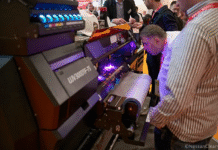Leading manufacturer of wide format printers and cutting systems, Mimaki had its biggest and most successful presence ever at FESPA 2017 with two stands totalling 534 square meters. The company showcased its solutions for sign and display graphics, industrial print, 3D printing and digital textile printing under the theme “Dare to print different”. During the show Mimaki Europe won Best Object Printer award for the Mimaki UJF-MkII Series and Best Textile Printer under 100 sq./h award for the Mimaki Tx300P-1800 with its dual ink capability. Mimaki Europe also introduced Yuji Ikeda as its new managing director.
Visitors showed interest in new technology like the 3D printer, the Mimaki 3DUJ-P, which is based on Mimaki’s advanced UV inkjet technology. The 3DUJ-P offers high-definition modelling with a maximum size of 500 x 500 x 300 mm. It is the world’s first truly full-color modelling solution and supports up to 10 million different colors with the ability to achieve 84% of the FOGRA39L color gamut with high definition printing. The Mimaki 3DUJ-P, which also includes clear ink and a water-soluble support material that can be simply washed away, is expected to be commercially available later this year.
With the new high-speed directto-textile Tiger-1800B printer, it was the first time that Mimaki showcased the printer with sublimation ink after demonstrating the machine with reactive ink in previous shows. Textile firm Estampados Hermanos Perez located in Mataró, Spain, and supported by Mimaki distributor Digidelta, purchased the printer from the show floor.
Mimaki also had on display the award-winning Tx300P-1800 and Tx300P-1800B direct-to-textile printers, updated to simultaneously load both textile pigment and sublimation dye inks. This enables the use of a single printer to print directly on a wide range of textiles without the need to change out ink systems.
Dare to print different Broek Ronald van den Broek, general manager – sales, says that many visitors to the stand were seeking solutions that would enable them to print on natural fibers with solutions like the Tx300P-1800 with textile pigment ink. In addition, visitors were interested in using sublimation printing for Fast Fashion and soft signage. “We also spoke with many companies wishing to repatriate processes they are currently outsourcing to different countries in order to gain more control by bringing them in house,” he comments.
On its stand Mimaki also displayed applications such as printed notebooks, dresses, etc. “We are very pleased about the results we achieved at FESPA 2017. It was our most successful edition to date, and the show continues to exceed our expectations every year,” van den Broek concludes.
















